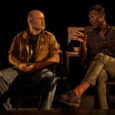Image courtesy of Sydney Symphony Orchestra. Photo: Jay Patel.
Jean Sibelius is undoubtedly Finland’s most celebrated composer. While typically remembered for his passionate symphonic works and concertos, Finnish conductor Osmo Vänskä’s latest show at the Sydney Opera House reveals a more enigmatic facet of the composer’s style.
Working with the Sydney Symphony Orchestra, Vänskä sought to showcase Sibelius’ fascination with Finnish myths and legends through a programme of orchestral and vocal pieces centred around ancient folklore.
The concert opened with the mystical <i>Pohjola’s Daughter</i> (1906). Sibelius composed this piece about the Finnish legend of Väinämöinen where a hero meets the goddess of nature. When the sparse cello solo began, a hush fell over the audience. Its desolate beauty immediately transported us to the misty waters and expansive moorlands of Finland.
There was a shift in the music when the woodwinds entered in a flurry of rapid ascending notes. This created a brightness that evoked the famous lights of the aurora borealis. Vänskä managed the sudden shift between the sparsity of the opening and the dense polyphonic texture of the second section masterfully. He effortlessly swapped his initial loose conducting style for one that was much tighter and precise.
Vänskä’s ability to guide the orchestra through quick changes in mood was further showcased in his selection of Sibelius’ songs. Finnish soprano Helena Juntunen performed these songs with breathtaking skill. While her performance traversed three distinct moods – dark intensity, light playfulness and finally jubilation – the songs were unified in their celebration of Nordic folklore.
The orchestra’s lush accompaniment perfectly balanced the icy purity of Juntunen’s voice. This was particularly noticeable in the French horn melody, which provided a necessary warmth to the higher-pitched sections of the vocal melodies.
Juntunen returned later in the evening to perform <em>Luonnotar</em> (1913). The piece is rarely performed due to the demanding nature of its solo sections. But Juntunen made these sections appear effortless through her playful engagement with the audience and emotional delivery of the song’s climax. While this climax could easily have made for an overwrought performance, Juntunen worked superbly with Vänskä to craft a nuanced soundscape filled with delicate ebbs and swells.
The Bard (1913) was one of the more unusual pieces in Vänskä’s selection. Only eight minutes in length and barely reaching above mezzo forte, the piece was far less dramatic than Sibelius’ well-known works. But while it was deceptively simple, the piece’s introspective tone was enchanting. The harp was central to this sense of enchantment, playing a continuous broken chord melody that had a mediative effect. Vänskä deliberately sustained the final unresolved harp chord, allowing the audience to hear the washes of sound echo throughout the spacious concert hall.
The final performance was the Lemminkäinen Suite (1896). Composed of four sections that depict heroic figures from Nordic folklore, the suite marked a return to the more familiar Sibelius. It followed a typical motific structure, where an initial three-note melody gradually built into a sweeping orchestral triumph. This sense of heroic passion, created by trumpet flourishes and thunderous timpani rolls, was reminiscent of Sibelius’ other orchestral works, including his infamous Violin Concerto in D Minor.
Vänskä also strived to emphasise the suite’s sense of folk magic. The audience heard this magic in the light, dance-like waltz of the first section which used traditional Finnish modes. The cor anglais solo in the second section was equally mesmerising, sharing that same sense of ancient solemnity we heard in the cello solo of Pohjola’s Daughter.
This enchanting programme certainly captured Finland’s rich culture of myth. Vanska’s retreat from Sibelius’ typical oeuvre allowed the audience to hear the composer in a novel way that retained a spectacular cinematic quality and reminded us why Sibelius continues to be so well-loved today.







